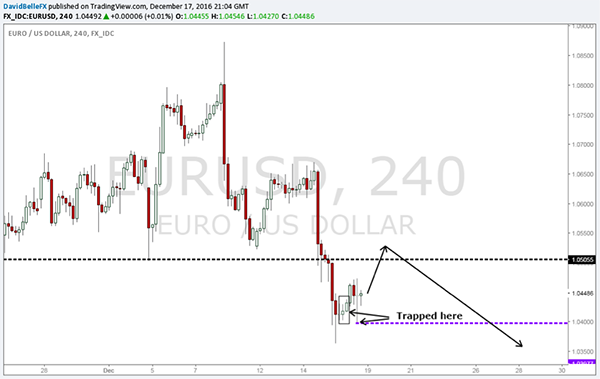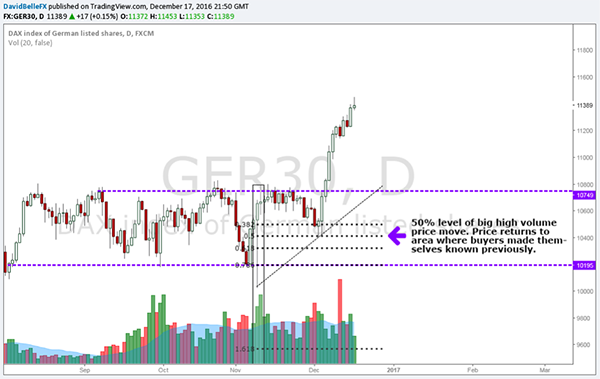This article is written by David Belle, a forex market commentator and independent trader. You can find more of his work at www.davidbellefx.com.
There are many articles showing the same technical analysis that everyone uses. So then ask yourself, why are 80% of these people losing money? Of course, part of it is due to poor money management, but the other part is due to retail traders being misguided. The following 5 tips will help you gain an edge against your fellow retail traders who are being fed the same dated analysis.
Some of these tips may sound a little bit complex, but this game does not always reward those sticking to basics. To set yourself apart from the herd, you must do your research and incorporate these tips into your own fundamental and technical analysis.
1. Anticipate Reversion to the Mean
Look for big moves on low volume. When traders step out of the market, this means that volume in the market decreases, and you can get wilder price movement. You could liken it to air resistance. The more air resistance, the harder it is for an object to move. The less air resistance, the easier and therefore further/faster an object can move through the air. This creates a scenario where the market looks to move back to areas where trades have been placed. Traders will either get stopped out, or they will close their positions in fear of being stopped out and price tends to continue in the original direction. Separate yourself from the beginners and trade accordingly.


2. Don’t Follow the Herd
Think of how big businesses became successful. Google, pioneered the search engine. Walmart, pioneered the big box retailer. Microsoft, Uber, Ebay, you know what they’ve done. Entrepreneurs are rewarded for being innovative, and creating their own path. Trading parallels this thought. Reward yourself by finding something that no one else is seeing. It doesn’t always mean to go against the crowds, it just means to think independently and don’t be scared to go where the crowds aren’t going. A lot of what is being taught on traditional trading websites is very generic advice, that EVERYONE follows. There is rarely anything special or unique to be found there. Find something that sets you apart from the crowd. Be the difference.
3. Study Trading Volume
I cannot stress this enough. Volume can tell you a lot about fear and greed at specific price levels. In addition, you can tell where buyers or sellers want to be heavily involved in the market. See below:

This is known as volume spread analysis. It can tell you about liquidity, or how easy it is to buy and sell an asset at a certain price. Volume spread analysis can also teach you a lot about current market interest. Both of these concepts are critical to understand how the real price drivers work. Buying and selling a 50% level of a large move is known as buying or selling the “creek”. This was coined by Richard Wyckoff and further developed by Tom Williams. Few educators truly understand volume, so it’s impact on how markets are analyzed by retail traders is routinely understated. Educate yourself about the true relationship between volume in the market coupled with price action.
The chart above shows a strategy that I use that combines the features of point 1 with some price strategies. Using the Fibonacci tool (this tool is utilized by drawing from a high to a low or a low to a high depending on trend direction (low to high in uptrend, high to low in down trend)) and then only looking at the 50% level, you buy or sell that 50% level when price touches it. You are always looking for price to move back with the prevailing trend direction.
4. Don’t Blindly Follow Sell Side Market Analysts
Don’t listen too much to the head analysts of the brokerage. If they were heavily involved in the market, and knew how to profit from movements in price, then they would be making more money trading. Looking back at previous points, look for rare occurrences in the market that you have found by yourself and try not to be too influenced with others telling you what to do. Be unique.
5. Be Systematic
Trading is meant to be boring when you are profitable. You want to look for the same event to occur again and again as it’s been tested already. When you are a beginner, you may feel that you want to learn everything at once. While this ambition is commendable, first focus on events based around price action that occur time after time, regardless if it’s a weekly chart, 1 hour, or even 1 minute. Try to build a checklist and document these events. Use this to tell you when to enter a trade, and when not to enter a trade. Why do the biggest banks, hedge funds, and financial institutions rely on algorithms to make money? Algorithms are emotionless, and don’t dither on whether to take a trade or not. Trade like a robot.
These points may seem daunting, however the earlier you start to adopt them then the bigger the chance you will give yourself to becoming profitable, and that’s what you want right?
